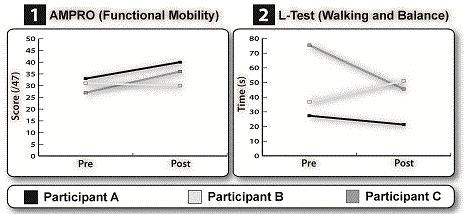Research Article Open Access
Assessment of the Feasibility of the Nintendo Wii Balance Board as an Intervention Method For Balance Rehabilitation with Lower-limb Amputees
| Michel Tousignant1,2*, Emilie-Sarah Milton-McSween2, Karine Michaud2, Simon Jolin2, Simon Bisson-Petit2, Richard Saba2, Emilie Limage-Couture3, Marie-Eve Luc3 and Marianne Labbé3 | |
| 1Research Centre on Aging, University Institute of Geriatrics of Sherbrooke, Université de Sherbrooke, Sherbrooke, Quebec, Canada | |
| 2School of Rehabilitation, Faculty of Medicine and Health Sciences, Université de Sherbrooke, Sherbrooke, Quebec, Canada | |
| 3Centre de réadaptation Estrie, Sherbrooke, Quebec, Canada | |
| Corresponding Author : | Michel Tousignant Research Centre on Aging University Institute of Geriatrics of Sherbrooke 1036 Belvédère Sud, Sherbrooke, Quebec, Canada J1H 4C4 Tel: 819-780-2220 E-mail: michel.tousignant@usherbooke.ca |
| Received November 11, 2014; Accepted January 21, 2015; Published January 27, 2015 | |
| Citation: Tousignant M, McSween MSM, Michaud K, Jolin S, Petit SB, et al. (2015) Assessment of the Feasibility of the Nintendo Wii Balance Board as an Intervention Method For Balance Rehabilitation with Lower-limb Amputees. J Nov Physiother 5:247. doi:10.4172/2165-7025.1000247 | |
| Copyright: © 2015 Tousignant M et al. This is an open-access article distributed under the terms of the Creative Commons Attribution License, which permits unrestricted use, distribution, and reproduction in any medium, provided the original author and source are credited. | |
Visit for more related articles at Journal of Novel Physiotherapies
Abstract
Lower-limb amputations have a major impact on balance and functional skills, which can be limited by rehabilitation. The Wii Balance Board (WBB) with its Wii Fit game (WFg) is often used in clinical settings with lowerlimb amputees but there is little research concerning its efficacy in improving static and dynamic balance. This study aims to assess the feasibility of using the Nintendo Wii Balance Board (WBB) and Wii Fit game (WFg) for balance rehabilitation with lower-limb amputees. A pre-/post-intervention pilot study design with no control group was used. Participants received 5 WBB and WFg rehabilitation sessions / week for 8 weeks. The length of the training sessions gradually increased from 10 to 30 minutes. Clinical outcomes were measured before (T1) and after (T2) the program and consisted of: 1) walking (L-test), 2) function and balance (Amputee Mobility Predictor [AMPPRO]), 3) satisfaction (Health Care Satisfaction Questionnaire [HCSQ]), 4) motivation (visual analog scale), and 5) quality of life (Trinity Amputation and Prosthesis Experience Scales [TAPES]). All participants (n=3) showed an improvement on all the clinical outcomes, except for the two functional tests, where one participant performed worse at T2 than T1. This pilot study demonstrated the feasibility of using the WBB and its WFg for balance rehabilitation with lower-limb amputees. Further research is needed to determine if this method is at least as effective as conventional interventions.
Tables and Figures at a glance
| Table 1 |
Figures at a glance
 |
 |
| Figure 1 | Figure 2 |
Relevant Topics
- Electrical stimulation
- High Intensity Exercise
- Muscle Movements
- Musculoskeletal Physical Therapy
- Musculoskeletal Physiotherapy
- Neurophysiotherapy
- Neuroplasticity
- Neuropsychiatric drugs
- Physical Activity
- Physical Fitness
- Physical Medicine
- Physical Therapy
- Precision Rehabilitation
- Scapular Mobilization
- Sleep Disorders
- Sports and Physical Activity
- Sports Physical Therapy
Recommended Journals
Article Tools
Article Usage
- Total views: 15492
- [From(publication date):
February-2015 - Aug 17, 2025] - Breakdown by view type
- HTML page views : 10822
- PDF downloads : 4670
